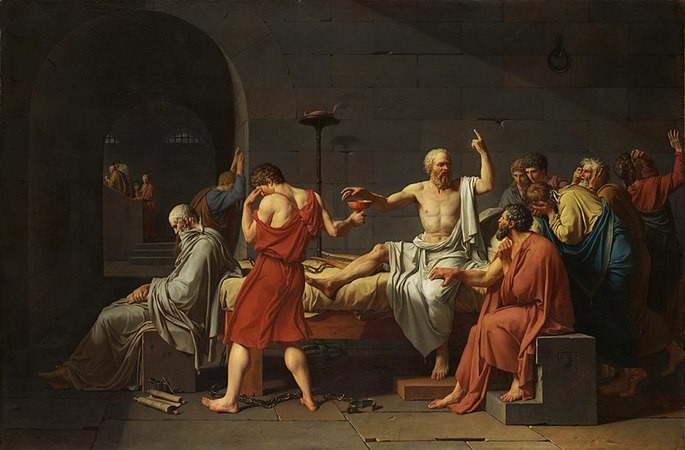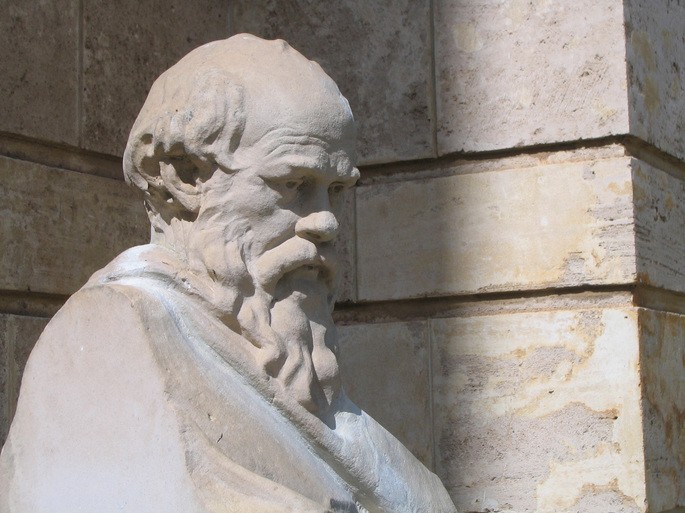Socrates (470-399 BC) is a major milestone in Western philosophy. Even though he is not the first philosopher, he is known as the “father of philosophy”. Much of this is due to his relentless pursuit of knowledge and the development of a method for that pursuit, the Socratic method.
In it, the Socratic dialectic aimed to question the usual beliefs of its interlocutor and later, assume its ignorance and seek true knowledge. The Socratic method seeks to remove doxa (opinion) and reach the episteme (knowledge).
For Socrates, it is only after falsehood is removed that the truth can emerge.
Therefore, his method of investigation consists of two moments: irony and maieutic.
1. Irony
The first part of the Socratic method known as irony, comes from the Greek expression which means “to ask, pretending not to know”. This first moment of the Socratic dialogue has a negative character, since it denies preconceptions, preconceptions and preconceptions (prejudices).
The irony was composed of questions asked to the interlocutor in order to make it clear that the knowledge he believed he possessed was nothing more than an opinion or a partial interpretation of reality.
For Socrates, non-knowledge or ignorance is preferable to bad knowledge (knowledge based on prejudices). With that, the questions of Socrates turned so that the interlocutor realized that he is not sure of his beliefs and recognized his own ignorance.
Socrates, with his questions, often bothered his interlocutors and they abandoned the discussion before proceeding and trying to define the concept.
Socratic dialogues that end up not being completed are called aporetic dialogues ( aporia means “impasse” or “inconclusion”).
2. Maieutics
The second stage of the Socratic method is known as maieutic, which means “childbirth”. In this second moment, the philosopher continues to ask questions, now with the objective that the interlocutor reaches a secure conclusion on the subject and is able to define a concept.
The name “maiêutica” was inspired by Socrates’ own family. Her mother, Fainarete, was a midwife and the philosopher took her as an example and claimed that the two had similar activities. While the mother helped women to give birth to children, Socrates helped people to give birth to ideas.
Socrates understood that ideas are already within people and are known for their eternal soul. However, the right question can remind the soul of its prior knowledge.
For the philosopher, no one is able to teach someone else anything. Only she herself can become aware, give birth to ideas. Reflection is the way to achieve knowledge.
Therefore, it is important to complete the maieutics. In it, from reflection, the subject starts from the simplest knowledge he already has and moves towards a more complex and more perfect knowledge.
This Socratic thinking served as the basis for the “theory of reminiscence” developed by Plato.
“I only know that I know nothing ” and the Importance of Ignorance
Socrates received a message from the Oracle of Delphi that stated that he was the wisest of Greek men. Questioning himself, Socrates said his famous phrase: ” I only know that I know nothing “, as could be the wisest.
Then, the philosopher realized that questioning and becoming aware of his own ignorance is the first step in the search for knowledge.
The so-called “wise men” were sure about their knowledge. However, they were nothing more than mere opinions or a partial perspective on reality.
Socrates realized that the security of these sages would make them never seek true knowledge. While he, being aware of his own ignorance, would always be looking for the truth.
Life without question is not worth living.

The Death of Socrates, portrays the moment after the judgment when the philosopher receives the chalice with hemlock
The Socratic Method and the Myth of Plato’s Cave
Socrates’ main disciple, Plato (c. 428-347 BC), in his famous Cave Allegory (or Cave Myth ), tells the story of a prisoner who was born chained at the bottom of a cave like many others.
Unhappy with his condition, this prisoner manages to free himself, leaves the cave and contemplates the outside world.
Not satisfied and feeling compassion towards the other prisoners inside the cave, the prisoner decides to return to the hostile interior of the cave to try to rescue other prisoners.
However, on his return, the other prisoners, discredited him, laughed at him and, finally, killed him.
Through this metaphor, Plato narrates Socrates’ trajectory in ancient Greece and what he understands as the role of philosophy.
For him, the questioning proposed by Socratic philosophy is the attitude that makes the individual perceive himself as a prisoner to a world of appearances and attached to his prejudices and opinions.
This restlessness is what makes the individual seek true knowledge, the way out of the cave. When you understand the truth illuminated by the Sun (truth), you become free.
Plato speaks of the role of the philosopher. The philosopher is one who feels compassion for others, who is not satisfied with having the knowledge for himself and must try to free people from the darkness of ignorance.
The tragic outcome imagined by Plato makes reference to the judgment and condemnation of his master, Socrates.
The Socratic method, especially irony, ended up bothering the powerful in Athens who were often ridiculed by the philosopher. The exposure of ignorance by the powerful Greek politicians condemned Socrates to death.
Socrates was accused of attacking the Greek gods and distorting his youth. He was found guilty and sentenced to take a hemlock (poison that causes paralysis and death).
Socrates surprised his followers and friends by refusing to flee and accept the condemnation. Among these followers was Plato .

